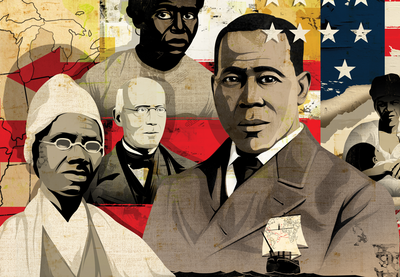While some states abolished slavery after independence, it remained legal in most of what is now the United States, expanding into some new states and across the South.
What Else Should My Students Know?
18.A Indigenous slavery was mostly eliminated in the East after the Yamasee War. In the West, slavery continued in Spanish colonies and in many newly acquired western territories even after Spain abolished slavery in its colonies.
18.B Abolitionists, including many who were formerly enslaved, were successful in making slavery illegal in the Northeastern states.
18.C Congress abolished the international slave trade in 1808, but enslavers then moved to trade people inside of the United States in large numbers.
18.D The cotton gin transformed the United States economy. White people developed the “Cotton Kingdom” in the Southeast with the forced labor of millions of enslaved Africans.
18.E As white people expanded plantation-based slavery throughout the Southeast, they increasingly demanded Indigenous land. The desire for cotton-rich lands led many white people to support the Indian Removal Act of 1830. The federal government used this act to forcibly remove Indigenous people from the Southeast.
18.F Cotton plantations were tied to the entire country. They produced cotton for Northern industry and bought food, clothing, tools and other goods from the entire country.
How Can I Teach This?
- Trade books like Frederick Douglass and the North Star and A Free Woman On God’s Earth: The True Story of Elizabeth “Mumbet” Freeman, the Slave Who Won Her Freedom show how important people of African descent were in the move to abolish slavery.
- Examine the role of white allies in the abolition movement, including William Lloyd Garrison and the Grimké sisters. Students can examine the nameplate of The Liberator to see how abolitionists depicted the evils of slavery.
- Students should examine a pre-Civil War map to identify states that abolished slavery and states where it remained legal. A map showing the boundaries of the “Cotton Kingdom” is a good accompaniment.
- Rebecca Onion and historian Claudio Saunt have made an interactive map that will help students to understand the expanse of territory that white settlers took from Native nations. Students should connect how racism (in this case, the idea that Indigenous people were not using the land “appropriately”) and capitalism (in this case, white people’s desire for increased lands for the use and profit of white people) contributed to the forced displacement of Indigenous people.
- Students can read Tim Tingle’s books How I Became a Ghost and When a Ghost Talks, Listen to understand the experiences of the Choctaw people in the days leading up to Removal and during the Trail of Tears.
- Students should examine the ways that people in free states indirectly benefited from enslaved labor by considering how the economies of Northeastern and Southeastern states diverged but remained intertwined. For example, students might examine how textile production relied on cotton grown by enslaved people in the Southeast. They should also discuss slavery when learning about westward expansion.
